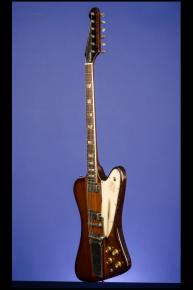An Original "Reverse" Firebird V.
1964 Gibson Firebird V "Reverse".
This 1964 guitar weighs just 8.50 lbs. and has a solid mahogany 'reverse' body. Five-piece mahogany neck through body construction with maple center strips. Standard Gibson scale length of 24 3/4 inches, nut width of just under 1 11/16 inches and a really fast medium profile. Serial number "240487" stamped in black on back of headstock. Bound rosewood fretboard with 22 original jumbo frets and inlaid pearl trapezoid position markers. Black plastic truss-rod cover with three screws. Individual Gibson Banjo-style tuners with rearwards tulip-shaped metal buttons. Two patent-number mini-humbuckers with outputs of 6.65k and 6.74k. Three-layer white over black plastic pickguard with a "Firebird" emblem painted on in red and eight screws. Four controls (two volume, two tone) on lower treble bout, plus three-way selector switch on pickguard. Gold plastic bell-shaped knobs with metal tops. The potentiometers are all stamped "137 6417" (CTS, April 1964). ABR-1 Tune-O-Matic retainer bridge with metal saddles, Gibson Deluxe Vibrola tailpiece with lyre-engraved coverplate and tubular arm with walrus tooth tip. All parts nickel-plated. There is some fine finish checking and some belt buckle wear to the back of the body. The top of the body shows some playing wear on the treble and bass sides of the center section by the neck pickup and there is some finish wear on the back of the neck. The tip of the pickguard has broken away as usual just by the screw-hole beneath the vibrato arm. The truss-rod cover is an original one from the period but has no lettering. The metal saddles on the original ABR-1 bridge have been replaced. With all that said this is an original 1964 Firebird V which has not suffered any breaks, has a totally original finish and has not been re-fretted. The guitar is in excellent plus (8.75) condition and is priced very competitively for one of these 'rare' birds. Housed in the original Gibson four-latch rectangular black hardshell case with orange plush lining (9.00).
The Firebird V was the equivalent of the SG (ex Les Paul) Standard.
"Announced in Spring 1963, the original Firebird series was conceived as an attempt to produce less conventional electrics likely to appeal to Fender players. Four different models, identified by odd Roman numerals, were marketed simultaneously...The four models produced between 1963 and 1965 (a.k.a. the 'reverse' Firebirds) share the same body specifications and differ only in fretboard style, electronics and hardware...The original Firebird electrics are primarily characterized by: a neck-through-body construction; a reverse body shape with extended lower horn; a reverse peghead with the treble E tuner nearest to the nut; banjo-style tuners with rearwards buttons; and they are all equipped with mini-humbuckers built without adjustable polepieces. The early samples are characterized by a 2-piece full length neck and a convex heel where the neck blends into the body. By late 1963, production models were released with a stronger 9-piece lamination and a smaller squared-off heel. A painted-on red Firebird emblem was also added on the white pickguard...For all practical purposes, the Firebird III was the equivalent of the Special found in the SG/Les Paul family. Compared to the FB I, the model is characterized by: a bound rosewood fingerboard; two pickups; individual volume and tone controls for each pickup; a 3-way toggle switch for pickup selection; a (short) Vibrola tailpiece with flat metal lever. In spite of a Vibrola tailpiece, the FB III sports the same bar bridge with a pre-set ridge as the FB I. And because of its stud-anchoring this bridge cannot be replaced by a fully adjustable Tune-O-Matic bridge...The original Firebird series remained in production for less than two years between Fall 1963 and mid-65" (A.R. Duchossoir, Gibson Electrics -- The Classic Years, pp. 198-199).
"New automobile designs out of Detroit had caught McCarty's eye, and he hired the man responsible, Ray Dietrich, to draw up some guitars. Dietrich sketched a series of models, and one was chosen. The new guitar bucked tradition with a treble-side horn longer than the bass horn -- the reverse of conventional style. The headstock, too, was reversed, with all the tuners on the treble side. To avoid an awkward tuning procedure, banjo-style tuners went straight out the back of the headstock. The neck went all the way through the body. The pickups were unique: mini-humbuckers with no visible polepieces. The new creations were dubbed Firebirds, and a flock of four models debuted in 1963. A new set of custom color finishes was introduced just for them" (Walter Carter, Gibson Guitars: 100 Years of an American Icon, p. 237).











